“Somewhere, something incredible is waiting to be known.” Carl Sagan
“If the result confirms the hypothesis, then you’ve made a measurement. If the result is contrary to the hypothesis, then you’ve made a discovery.” Enrico Fermi
 I am a researcher at the CICTERRA, Centro de Investigaciones en Ciencias de la Tierra and a professor at the Geology Department, in the Universidad Nacional de Cordoba. During 2019 and 2020 I was a visiting professor in Sedimentology/Stratigraphy and Biogeochemistry at the Earth and Planetary Sciences Department, Washington University (Saint Louis, USA).
I am a researcher at the CICTERRA, Centro de Investigaciones en Ciencias de la Tierra and a professor at the Geology Department, in the Universidad Nacional de Cordoba. During 2019 and 2020 I was a visiting professor in Sedimentology/Stratigraphy and Biogeochemistry at the Earth and Planetary Sciences Department, Washington University (Saint Louis, USA).
I am just a member of a multidisciplinary group of people that include geologists, paleontologists, microbiologists, chemists/geochemists and geophysicists with some common goals and interests, that over the years have been collaborating (formally or informally and in different ways) to answer some specific scientific questions that can be included in the broad field of Geobiology. These collaborations were essential to be able to accomplish some of our research goals, mostly given the scarcity of funding and resources that sometimes we face while doing science in Argentina. So, what is shown in this website is of course the work with all these people that I was lucky to meet, work and interact with, and with funding from the CONICET, the MINCYT and the SECYT and some external sources and collaborations with several colleagues. This people include: Cecilia Mlewski, Flavia Boidi, Ariadna Coppa Vigliocco, Agustin Mors, Ricardo Astini, Mateo Martini, Eliana Soto Rueda, Laura Borgnino, Marcelo Carreras, Mara Matic (all CICTERRA members), Nicole Pietrasiak (New Mexico State University), Alex Bradley, David Fike, Scott Beeler, Jenn Houghton (Washington University, Saint Louis, USA), Linda Kah, Rob Riding (Department of Earth and Planetary Sciences, University of Tennessee, USA), Miles Henderson (University of Texas, Permian Basin, Odessa-USA), Joy Buongiorno (Maryville College, Tennesse, USA), Emmanuelle Gérard, Benedicte Ménez, Celine Pisapia, (IPGP-Paris, France), Karim Benzerara (CNRS-Paris France), M.E. Farías, Patricio Villafañe, Agustina Lencina (LIMLA, CONICET, Tucumán), Rogerio Schiffer, Lisie Falcão, Bárbara Teixeira (PETROBRAS) as well as other people from CENPES, PETROBRAS, among many many others.
“Ubuntu ngumuntu ngabantu” (I am because we are and I am human because I belong) Proverbio Zulu.
El concepto de Ubuntu is an African philosophy that places emphasis on ‘Being human through other people’. It has been succinctly expressed in the phrase I am because of who we all are (Mugumbate and Nyanguru, 2013. African Journal of Social Work, 3(1):82-100)
My research focus on several aspects, including basin-scale studies of carbonate and mixed sedimentary systems (stratigraphy and sedimentology) as well as the biogeochemistry and geomicrobiology of carbonate precipitation. As a member of a multidisciplinary research group our goal is to understand physico-chemical and biological processes involved in carbonate precipitation. We are interested on using this information to better understand the complex interactions between the Geosphere and the Biosphere, and how these interactions are preserved in the sedimentary record. Understanding microbe-mineral interactions and biogeochemical cycling of biologically significant elements (C, O, N, S, P, trace elements) and how this information is preserved in sedimentary carbonates is extremely important to define biosignatures (signals of biological activity). This allow us to track the evolution of the biosphere and its impact on the environment. Thus, our research is also focused on Astrobiology, where we use modern and ancient environments to study the evidences of life (mostly microbial) in the sedimentary record on Earth. This information can help in the search of active or fossil life in preserved in the sedimentary record in other planets such as Mars so some of our projects are focused on Mars analogue environments (Laguna Negra, termas Los Hornos, Lago Strobel).
We work on modern and ancient environments with a comparative analysis approach, and our focus is carbonate sedimentology, biogeochemistry and geomicrobiology under a diverse set of environmental conditions, to unravel the physical, chemical and biological controls. This includes hypsersaline (The Laguna Negra) and freshwater lakes (Strobel Lake), marine carbonates (Lower Paleozoic and Cretaceous carbonates) as well as hot springs and fluvial carbonates deposits (Terma Los Hornos, siliceous sinters, tufa and travertines).
Since we want to cover a wide spectrum of environmental conditions where carbonate precipitation takes place, these are the selected research areas:
High-altitude hypersaline lakes
The Laguna Negra is a high-altitude hypersaline lake where the extreme environmental conditions there recorded (low water activity, high UV-radiation influx, extreme daily temperature changes, etc) are similar to those typically interpreted for some ancient sedimentary environments in the Early Earth (for example the Archean Meentheena Member, Tumbiana Formation in the Fortescue Group, Western Australia) as well as other planets such as Mars (sedimentary deposits at the Jezero and Gale Craters). In the Laguna Negra we can observe a spectrum of conditions for carbonate mineral precipitation, from completely abiotic to biologically influenced. This results in the development of a wide carbonate belt represented by carbonate stromatolites and oncoids deposits as well as abiotic laminar crusts, that allow us to investigate microbial and physico-chemical controls on carbonate precipitation and the preservation of biosignatures. Over the years we have been actively working in this unusual site with different approaches and several colleagues such as Cecilia Mlewski (CICTERRA), Mara Matic (CICTERRA), Alexandra Rodler (University of Natural Resources and Life Sciences, Vienn) Emmanuelle Gerard and her group at IPGP (Paris, France), Flavia Boidi (CICTERRA), Joy Buongiorno (Maryville College, TN, USA), Linda C. Kah (University of Tennessee, TN, USA), Julie Barltey (University of Minnesota, USA), Scott Beeler, Alex Bradley and David Fike (Washington University, Saint Louis, USA). In addition, I have been invited to collaborate with M.E. Farías (CONICET), Patricio Villafañe (CONICET) and Agustina Lencina (CONICET) in the study similar sites in the area, including interesting oncoids and microbialites at Pozo Bravo y Las Quinoas (Catamarca, Province).
Some recent papers of our research include (see details about full references in my CV section) Gomez et al (2014, 2018, 2020), Beeler et al (2020), Buongiorno et al (2019), Mlewski et al. (2018), Shalygyn et al. (2019), Boidi et al., (2020); Lencina et al., in prep. Villafañe et al., in press.
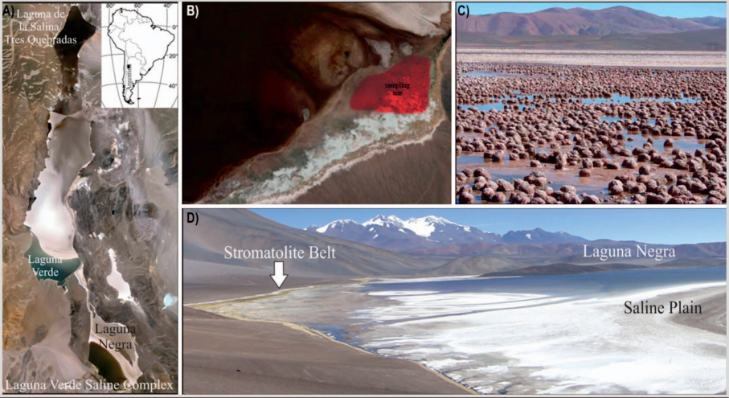 Image credit: Gomez et al., 2018
Image credit: Gomez et al., 2018
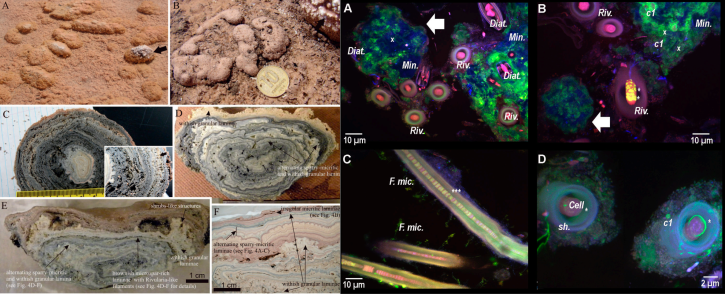 Image credit: Gomez et al., 2018; Mlewski et al., 2018
Image credit: Gomez et al., 2018; Mlewski et al., 2018
Hot springs, tufas and travertines
Hot springs are interesting sites from a geomicrobiological and astrobiological perspective since these are typically colonized by complex microbial communities where rapid mieneralization takes place. These systems have been a target in the exploration of Mars, where sedimentary deposits related to hot springs have been recorded (for example in the Columbia Hills, Gusev crater). For this reason we selected several high-altitude hot springs in the Catamarca Province (for example Termas Los Hornos) to better understand an environment where mineral precipitation is typically controlled by physical-chemical processes such as carbon dioxide degassing and temperature changes and where silica and carbonate precipitation are common. This provides an excellent place to test textural and geochemical biosignatures preservation and mineralization of microbial remains. Here, together with Agustin Mors (CICTERRA) (who developed his PhD project in this area), Anabel Piersigilli (undergad student, Universidad Nacional de Córdoba), and Ricardo Astini (staff researcher at CICTERRA) as well as external colleagues such as Frank Corsetti and his group (University of Southern California) we try to understand the main controls in facies and microtextures on these sedimentary deposits and the biogeochemical signatures these deposits may preserve. For example, recently we have focused on two specific spheroidal particles: pisolites and spherulites formed by the same fluid chemistry, but under different environmental conditions. The Los Hornos pisolites were formed under agitated waters devoid of significan biological influence and the spherulites were formed under calm, low-energy conditions, colonized by a diverse microbial biosphere (including abundant cyanobacteria and diatoms). These carbonate particles show remarkable textural and geochemical differences that we are exploring to better understand biotic and abiotic signatures and biosignautres modifications during early diagenesis in these continental settings.
Some recent papers about this research (see details about full references in my CV section) include Astini et al., (2018); Mors et al., (2019); Piersigilli et al., (2020); Mors et al., submitted.
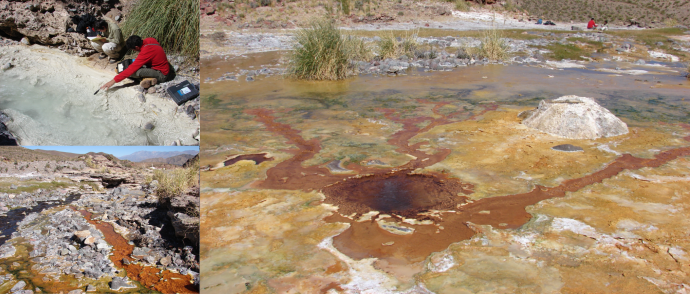 Image credit: Dr. Agustin Mors and Dr. Fernando Gomez
Image credit: Dr. Agustin Mors and Dr. Fernando Gomez
Basalt hosted lakes as Martian analogues
In the search for Earth-based sedimentary environments analogues for those recorded on Mars, we staterd working in the Strobel Lake in the Patagonia of Argentina. The Strobel lake is a fresh-water lake developed on a basaltic bedrock and a semi-arid climate, where a suite of sedimentary environments and related sedimentary deposits include shallow to deep lacustrine deposits, fluvial to delta deposits, and an extensive carbonate belt where abundant fossil and active microbialites (stromatolites and thrombolites) have been recorded. Our goal here, together with Cecilia Mlewski (microbiologist at CICTERRA) and Emiliano Rivarola (Geologist and PhD candidate at CICTERRA) is to study these deposits with an astrobiological perspective integrating multispectral image analysis, sedimentology, biogeochemistry and geomicrobiology. This site is interesting since fluid-rock interaction, weathering processes, authigenic mineral precipitation and associated geomicrobiological and biogeochemical processes must be similar (in some aspects) to those that could be observed or recorded on Mars surface. Particularly, since recently NASA has launched a probe (Perseverance, landing in february 2021) to explore the lacustrine and delta deposits of Jezero Crater, where also abundant carbonate sedimentary units have been recorded. This makes the Strobel lake a fascinating planetary analogue for Jezero Crater.
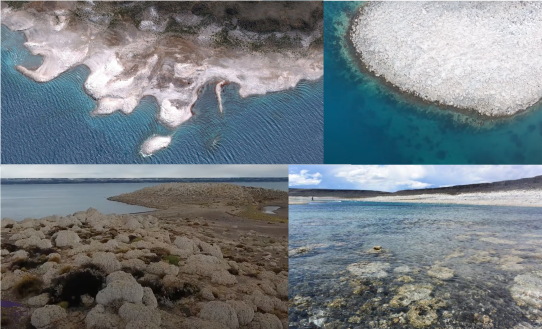 Image credit: Jurassic Lake and Google Earth
Image credit: Jurassic Lake and Google Earth
 Image credit: Mars images from Horgan et al., 2020, Icarus 339, Strobel image: Jurassic Lake
Image credit: Mars images from Horgan et al., 2020, Icarus 339, Strobel image: Jurassic Lake
Creataceous lacustrine, marine-marginal carbonates
An interesting carbonate and mixed sedimentary system of Cretaceous age is recorded in the Yacoraite Formation, preserved in the stratigraphy of the Creataceous basins of Salta and Jujuy provinces, in Northwestern Argentina. This site is interesting for several reasons: 1) it is still debated if these deposits are lacustrine, mixed or completely marine and if thus these may represent important sea-level fluctuations recorded inland after the Pangea break-up. 2) These deposits have an interesting record of a diverse (meter-scale) suite of microbialites (stromatolites) and associated ooids-rich calcarenites arranged in meter-scale cycles. These calcarenites host some beatifully preserved ooids, formed under different environmental conditions and that allow studing the different environmental settings for ooids formation and their diagenetic transformations. 3) The Yacoraite Formation record the K-T boundary which still is cryptic in this area and in most of this basin. 4) The Yacoiraite Formation has been used as an exposed sedimentary analogue for the unusual carbonates that host the world-class oil reserves known as the the Pre-Salt, located in the off-shore basins of Brazil and on the Africa coast. Ariadna Coppa Vigliocco (CICTERRA) is a grad student currently working with Ricardo Astini (CICTERRA) and myself on the stratigraphic correlation and environmental intepretation of this interesting unit. In addition she is working on a detailed analysis of ooids morphogenesis, microtextures and the geochemical signatures to unravel primary formation processes and diagenetic alterations.
Some recent papers about this research (see details about full references in my CV section) include Astini et al., (2020), Coppa Vigliocco et al., submitted.
 Image credit: Ariadna Coppa Vigliocco, Fernando Gomez
Image credit: Ariadna Coppa Vigliocco, Fernando Gomez
The Cambro-Ordovician Precordillera carbonate platform and the Triassic rift related carbonates and siliciclastics
During my PhD I focused on understanding the evolution of the lower Paleozoic Precordillera carbonate platform (San Juan Province, Argentina). The Precordillera represents a microterrane detached from the Laurentia margin in the early Cambrian and after rifting and drifting stages it was accreted to the western margin of Gondwana in the Mid-Upper Ordovician. Its 2500 m of sedimentary rocks thickness record this geotectonic evolution as well as the evolution of the Lower Paleozoic biosphere, oceans/atmosphere and sedimentary environments. Our work there has focused on understanding the Precordillera stratigraphy and sedimentology, improving correlation between different sections using different approaches including chemostratigraphy and dating techniques. In addition, together with Ricardo Astini and Marcelo Carrera (both at CICETRRA) we have studied microbial as well as metazoan reefs preserved in the different sedimentary units. With Miles Henderson and Linda Kah, we are trying to understand the carbon and sulfur biogeochemical cycles, in order to improve the current models, combinig chemostratigraphy and numerical modeling techniques (box models). In addition to the Lower Paleozoic deposits, together with Ricardo Astini (CICTERRA) and Bárbara Teixeira (PETROBRAS), we worked on some interesting Triassic deposits in the Precordillera, related to the generalized Triassic extension that characterized the northwestern or Argentina. We applied a source-to-sink approach to understand sediment provenance and basin infill as well as paleoclimatic evolution of these mixed carbonate-siliciclastic rift-related depotis.
Some recent papers about this research (see details about full references in my CV section) include Gomez and Astini (2005, 2006, 2015), Gomez et al., (2007), Carrera et al., (2017); Teixeira et al., (2018), Henderson et al., in review.
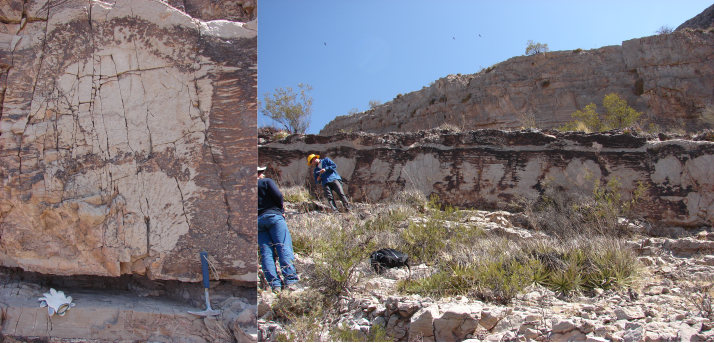 Image credit: Fernando Gomez
Image credit: Fernando Gomez
Understanding the pre-Salt reservoirs and their unusual carbonates
Over about 5 yeas, together with Dr. Ricardo Astini we have been collaborating as consultants with colleagues at the CENPES (Centro Nacional de Pesquisas, Petrobras, Río de Janeiro) looking at the pretty unusual sedimentary carbonates of the Pre-Salt, in the off-shore basins of Brazil (Campos, Santos, etc). This research motivated some of our projects in order to understand better microbial carbonates formed under different conditions (hots springs, hypersaline and freshwater lakes and marine environments) in the search for good analogues for the Creatceous carbonates typically observed in the Brazilian basins and that host some of the biggest oil reserves in the world.
Although most of our work wiht Petrobras was unpublished (given a confidentiality agreement), some work in preparation about this research was authorized and will be ready to be published soon and this include collaborative work with Lisie Falçao and Rogerio Schiffer, both at CENPES, where we did some comparative analysis between Quaternary travertines in San Juan (Argentina) and some drill cores of the pre-Salt carbonates that we interpreted as possible travertine deposits.
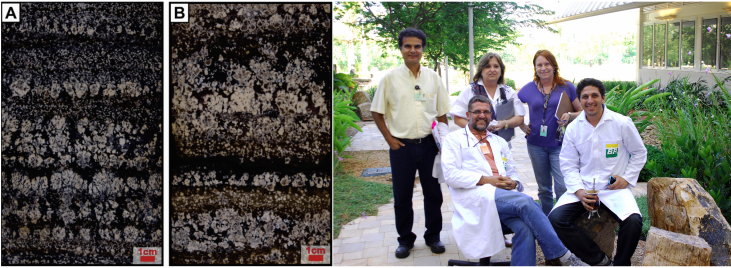 Image credit: Fernando Gomez
Image credit: Fernando Gomez
Machine learning approach applied to carbonate geochemistry
Data science (classic Statistics as well as Machine and Deep Learning) has changed the way we do science, giving us the chance to deal with abundant and multidimensional information. Our work, because of the multidisciplinary nature of our approach, by integrating microbial diversity data (for example metagenomics), geochemical, mineralogical and textural data, produce a huge amount of information that can be challenging to use and intepret. Machine learning and Deep learning techniques allow us reduce dimensionality, to find patterns in data and extract useful information for our purposes. For this reason we are applying this approach to extract information from the different research sites we have been working on, particularly the Laguna Negra and the Terma Los Hornos in order to explore the use of these techniques to extract biosignatures from geochemical and microbial diversity data, and the preservation or alteration of these biosignatures.
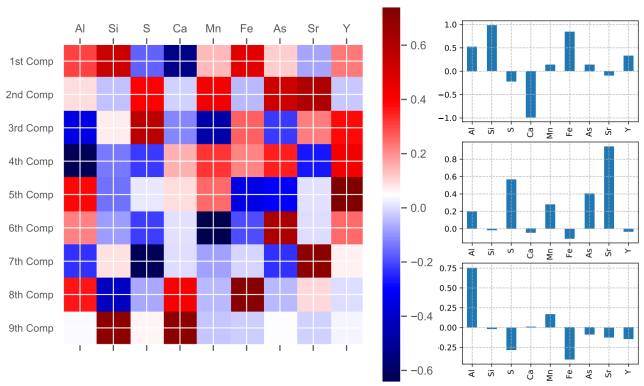 Image credit: Fernando Gomez
Image credit: Fernando Gomez
I am really excited to annouce that we have a new grad student, Emiliano Rivarola, that will be working on microbial carbonates in the Strobel Lake in Santa Cruz
December 16, 2020I am happy to know that I have been included in the working group of Planetary Environments and Habitability, in the European Astrobiology Institute
December 16, 2020Together with Mateo Martini, we became part of the Europlanet RI-TA-PFA (Transational Access for Planetary Field Analogues). We will collaborate with researchers from EU in Astrobiology focused research in terrestrial planetary analogues
18 August, 2020Together with Dr. Cecilia Mlewski, we just submitted a PhD project for a new future grad student (Emiliano Rivarola) to work on the sedimentology and geochemistry of Strobel lake, in Patagonia. Strobel lake is a basalt-hosted freshwater lake that we consider is a good Earth-based analogue environment for the Jezero crater lacustrine sedimentary deposits on Mars, where the Perseverance rover recently launched by NASA is going to land. Our plan is to study microbe-mineral interactions and biosignatures preservation in the Strobel Lake sedimentary deposits that may provide some insight to better understand Jezero crater sedimentary record.